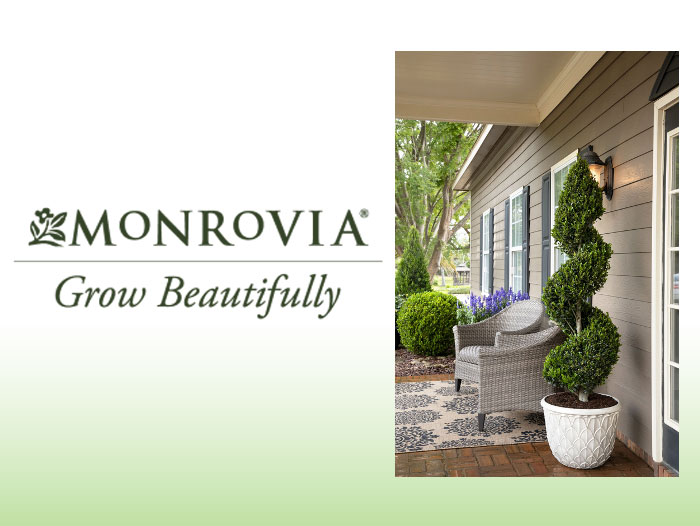Use Beautiful Plants to Create a Statement in Your Landscape
July 22, 2020 | 4 min to read

These days we are all staying closer to home. The extra time we spend looking at or in our gardens is giving homeowners a new appreciation of the value of a beautiful landscape. One way to add instant and long-lasting beauty to the landscape is with statement plants—those that lend a bold, architectural look as they dramatically fill their allotted space.
“Statement plants are the difference between an ordinary yard and a beautiful garden,” says Jonathan Pedersen, Monrovia Vice President of Sales and Business Development. “Make your landscape a source of inspiration and pride, an extension of your personality. Plants help you do that.”
Centuries of gardening history show how stunning landscapes use statement plants. These varieties are used as focal points, space dividers, and to direct flow, adding structure to large and small spaces. “Think of the statement plant as the jewel and the surrounding garden as the setting,” says Margie Grace, Landscape Designer and author of Private Gardens of Santa Barbara: The Art of Outdoor Living. “You can pair the loveliest of accessories (the “statement plant”) with the simplest of settings (think “little black dress”). Done thoughtfully, this approach yields an elegant composition.”
Statement Plants as Focal Points
“Every space needs a focal point, a place where the eye is drawn to,” says John Robert Beaudry, Landscape Designer and author of the new book Garden Sanctuary: Designing for Comfort, Wholeness and Connection. “Having a place for the eye to stop makes a garden feel more restful. The right focal point can be something that lifts spirits or adds excitement.”
One way to utilize a statement plant as a beautiful focal point is to select a variety with dramatic form. Large topiaries (trees and shrubs pruned in ornamental shapes), trellised shrubs (those trained vertically on a trellis), and espaliered trees (trained to grow in a pattern along a frame) all immediately draw the eye to their dramatic architectural form.
Monrovia grows more than 200 types of topiary specially pruned to add structure to landscapes. “Topiary can take eight years of growing and shaping before they’re ready for the garden center,” says Pedersen. “It’s not just about growing plants. It’s about how we cultivate plants that add eye-catching beauty to gardens and landscapes with their form and structure—something homeowners can enjoy immediately.”
Statement Plants to Define a Space
A focal point is one way to enjoy a statement plant in your landscape. You can also utilize plants that add beauty and architecture to divide your landscape into different areas or rooms. Breaking your landscape into a series of rooms with structural plants like Mint Julep® Juniper or espaliered Chollipo Euonymus makes walking through it an exercise in discovery. Plant several large evergreens together (either in your landscape or a decorative container) to create a natural wall. Emerald Colonnade® Holly, for example, offers dense and glossy, bright-green foliage. It is a beautiful choice as a living screen to split one space from the next.
Statement Plants for Guiding Visitors
Another way employ statement plants in your landscape is to instruct directional flow. Intentional placement of a line of Purple Fountain Grass can direct visitors along a pathway and offer a natural sense of movement. Or plant a low hedge, such as Boxwood, as an instant design element that is beautiful and functional. Boxwood’s dense, deep green foliage is perfect for directing visitors from the side yard to the backyard, for example.
Statement Plants for Natural Gardens

Plants pruned into special shapes fit in many design styles. For other landscape looks, homeowners can enjoy plants that naturally make a statement with their form, texture, or color. Trees like Japanese Maples are classic choices. Their distinctive, finely cut leaves and dramatic, sculptural shapes are often used in Asian garden design. Their beauty in the landscape transcends any specific design style, however.
Monrovia takes the time needed to bring beautiful Japanese Maple specimens to market. From planting the seeds, to grafting, growing, and shaping, the process can take more than six years. “The result is an exceptionally healthy tree that is ready to be planted in the home garden and flourishes after planting,” says Pedersen. From Velvet Viking™, the first Japanese Maple hardy to Zone 4, to the striking Shin Deshojo that changes colors through the seasons, a Japanese Maple makes a statement.
Statement Plants for Decks, Patios, and Porches
You can enjoy the beauty of statement plants in outdoor living areas such as decks, patios, and porches, as well as your landscape. A pair of poodle topiaries (those pruned with sections of trunk separating spheres of foliage) flanking a front door is a simple way to add beauty to an entry, for example. Or add height and an architectural look to a patio by placing potted Euonymus topiary along its perimeter. Take your deck from bland to beautiful with a pair of Lemon Swirl® Australian Brush Cherry spiral-shaped topiaries. Or enjoy a wall of color with Purple Queen® Bougainvillea on a trellis and espaliered Apple Blossom Camellia.
###
About Monrovia
Inspired by the beauty of plants, gardens, and landscapes everywhere, Harry E. Rosedale founded Monrovia in 1926 to be a premier grower of shrubs and trees. Monrovia collaborates with plant breeders around the world to introduce improved plant varieties to North America. Monrovia plants flourish once planted to beautify gardens and landscapes. Please visit www.monrovia.com.
